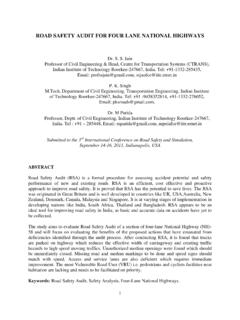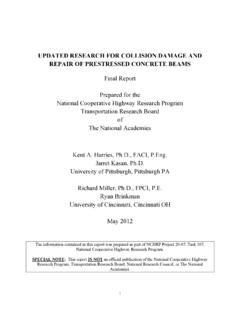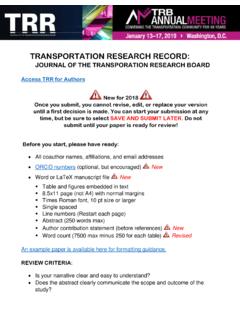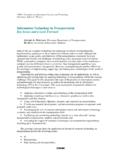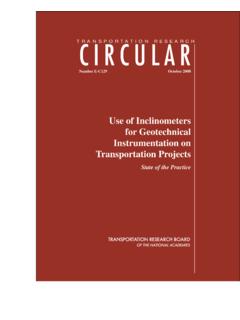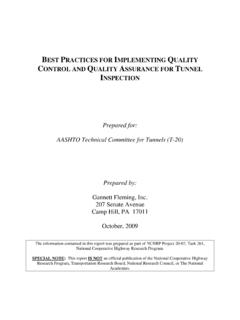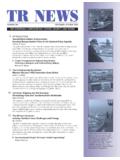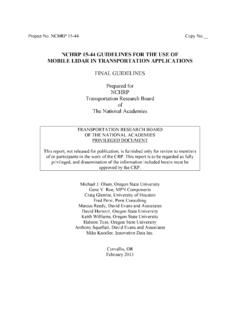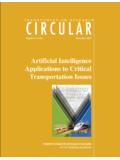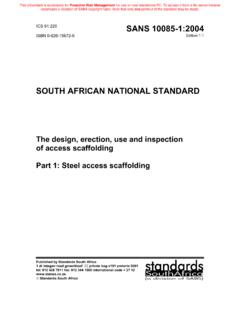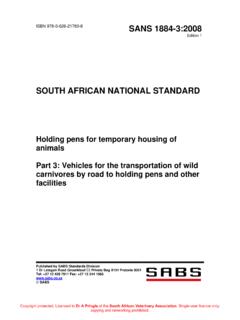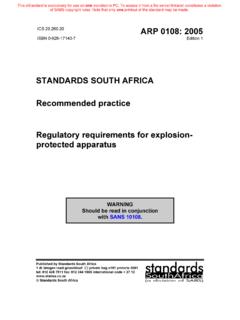Transcription of South African Parking Standards
1 42 20. Parking As A Factor In Business. HRB, Special Rept. 11, 1953. 21. Olsson and Miller. The Impact on Commuters of a Residential Parking Permit Pro-gram. Urban Institute, Washington, DC, Dec. 1979. 22. Vuchic and M. Suleiman Hessami. Parking Policy as a Transportation System Management Measure. Univ. of Pennsylvania, Philadelphia, Final Rept., Aug. 1978. 23. Moulton. Analysis of Residential Permit Parking in Washington, DC. Catholic Univ., thesis, Nov. 13, 1978. Transportation Research Record 816 24. H. Simkowitz and others. Parking Permit Pro-grams to Restrain the Automobile in Residential Neighborhoods. Proc., Transportation Research Forum, 1979. 25. Pratt and Associates, Inc. Transportation Controls for Air Quality Improvement in the national Capitol Region. Metropolitan Washing-ton Council of Governments, Washington, DC, Oct. 1976. Publication of this paper sponsored by Committee on Transportation System Management. South African Parking Standards MACKEY, VANZYL, AND VORSTER Certain minimum desirable Parking Standards were developed in the Urban Tra nsport Branch of tho South African Det>artment of Transport during 1979-1980.
2 This was done to provide guidanco and requirements for uniform park ing Standards . This paper conveys these Standards and some of the background to the development of the Standards . The subject is dealt with in two parts: Standards for Parking dimension and requirements for Parking provision. In the first section, the establishment of a South African design vehicle is dis cussed-motor cars in South Africa are generally smaller than those in the United States and slightly larger than the European cars. From tho design vehi de, at present proposed to be m in length and m wide, the dimensions of Parking bays and aisle widths are derived and certain Standards proposed. For 90 Parking a basic standar d module width is wide aisles. Dimon sions for angle Parking and for on-street Parking are also proposed as well as dimensions for cortoln Parking garages. In tho socond section, th o background t o tho development of roquiremonts for provlsion,of off-street Parking is dis-cussed.
3 A questionnaire on current Parking provision require ments was sont to all local authorities in the five declared metropolitan areas in South Africa. The results of this survey were compar ed wilh findings of Parking d emand survoys and South Afrieon and overseas proposed standard s. A summary o f the re com-mended minimum doslrnble Standards for park ing provision is thon Parking is a very important and integral part of the total transportation system in any metropolitan area. Because of the ever-increasing cost of land and construction of Parking facilities and also because of the influence of on-street and off-street Parking on traffic flow, it is necessary for all authorities to e nsure compliance with adequate, realistic, and effective Parking r e quirements and Standards . The Urban Transport Branch of the Department of Transport therefore compiled a report on Parking Standards OJ, of which this paper is a summary. The object of the report was to propose (a) Standards for Parking dimension and (b) require-ments for Parking prov1s1on to provide national guidance and requirements for uniform Parking stan-dards and also to assist t he national Transport Com-mission in evaluating requests for subsi d ies for Parking facilities.
4 The national Tr a n sport Commission accept ed, in principle, t he p arki ng-dimensi o n Standards and park-ing-prov ision requirements, as laid d own i n the report, as the minimum desirable Standards for the urban areas of South Africa. The commission further agreed that the report be distributed to all local authorities in the declared metropolitan transport areas, that it should be recommended to the core cities for possible acceptance and application in their respective transport plans, and that all local authorities should consider inclusion of the Parking provision requirements in their town planning schemes, with the understanding that deviations would be possible if adequate motivation proves it necessary. The purpose of the report was to cover only those aspects of Parking that may differ from available overseas Standards and requirements. The use of other literature on Parking in conjunction with this report is thus recommended [ , (1_)]. Standards FOR Parking DIMENSIONS South African Design Vehicle Minimum Standards and desirable Standards for dimen-sions of Parking bays can be laid down.
5 For the purpose of this report, we decided to propos e only one desirable standard that will be applicable to most circumstances. Good judgment is necessary, however, in the application of these Standards , and certain deviations may be necessary. These stan-dards apply only to ordinary private vehicles such as motor cars, minibuses, and light delivery vehi-cles but not to trucks and buses. South African motor cars are generally smaller than those in the United States and probably slightly larger than European cars: therefore, it was necessary to de-velop a South African design vehicle from which di-mensions of Parking bays can be derived. A number of people, including the city engineer's department of Durban (3), Olivier (4), Uys and Van der Merwe (..?_), and th;-Division of -Highway Traffic Engineering of the South African Institute of Civil Engineers <ilr did some work on the dimensions of a South African design vehicle. Most of the above-mentioned studies based the design vehicle on the 95 percentile value of the different dimensions.
6 This represents a conservative working value that covers the overall majority of vehicles. Cumulative fre-quency diagrams were plotted for such factors as the length, width, turning circle, and height of vehi-cles from which the 95 percentile values can easily be determined. Uys and Van der Merwe (..?_) found a definite trend toward smaller cars in South Africa. Volkswagen South Africa (7) confirmed this after studying the change in buyi;;g habits of the South African motor -ing public. They found an increase of 15 percent in Transportation Research Record 816 43 Table 1. Comparison of design vehicle d imensions. Place Source Length(m) Width(m) Turning Circle (m) United States Eno Foundation (jl_) Eno Foundation(~) Institute of Traffic Engineers ( ) Institute of Transportation Engineering (l!) Europe Glanville and Seymer (11) South Africa Durban Corporation (J) 4 .88 South African Institution of Civil Engineers( ) Olivier (,i) Uys and Van der Merwe (~) Proposed Note: The foJJowing factors are generally accepted to play a rnle in determining dimensions of Parking bays: vehicle size dimensions, o perational characteristics, driving ability.
7 And user convenience. Figure 1. Design vehicle and 90 stall..J ..J "" ,_ "' 2 .5 END OF STALL the number of new small cars sold in the period 1973 to May 1979 and a further increase was expected. After the available data were compared, the fol-lowing basic dimensions for the South African design vehicle were proposed: Item Length Width Dimension Im) Turning circle A comparison between these dimensions, as set by various sources for the United States, Europe, and South Africa, is presented in Table 1. The follow-ing additional characteristics for the South African design vehicle were then chosen (the front, rear, and side overhangs were based on limited data only) : Item Wheel base Front overhang Rear overhang Side overhang Minimum turning radius, inside rear wheel Dimension (m) Minimum turning radius, outside point, front bumper Overall height The vehicle size dimensions will, to a certain extent, affect the bay and aisle dimensions. The most important dimensions are the following: 1.
8 Vehicle width; 2. Vehicle length; 3. Minimum turning radius, inside rear wheel; 4. Minimum turning radius, outside front bumper; and 5. Rear overhang. These dimensions affect the maneuverability of a vehicle directly and, therefore, the Parking layout and dimensions. Another important factor is the lateral spacing between vehicles when parked or be-tween a vehicle and a wall or other fixed objects, primarily for the opening of doors. After consid-eration of proposals by various authors and the variation in car positioning in the stall, a stan-dard of O. 7 m was proposed for design purposes. Kanaan and Witheford (11_) found that parkers did not, on the average, pull all the way into a Parking bay. Therefore it was proposed that an additional O. 2 m should be added to the length of the design vehicle in determining stall lengths. No provision was made for vehicles Parking with part of the over-hang extending over curbs or sidewalks because park-ing like that might interfere with pedestrian activ-ities and might also damage certain vehicles.
9 Off-S t r eet Parking If the tolerances mentioned above are added to the dimensions of the design vehicle, it results in a proposed general 90 bay size of m in length and m in width, as shown in Figure 1. A Parking bay next to a wall should be m wider, however, to allow for the opening of doors. This results in a bay size of 5 m in length and min width. When the standard Parking bay width is known, t h e width parallel to the end-of-stall line can be de-termined for different angles. The stall depth per-pendicular to a wall or the end-of-stall line for different Parking angles, with or without the inter-locking of bays, can also be determined. A summary of these dimensions is given in Table 2. Ricker (14) derived a formula for determining the aisle width between a row of parked cars and a wall or obstruction. This formula produces rather wide aisle widths, and, therefore, Parking maneuvers were also simulated graphically to determine the proposed aisle widths given in Table 2.
10 The proposed aisle width for 90 Parking is m. A Parking module, which represents two rows of Parking bays together with the aisle in between, is a standard dimension in planning and designing a specific Parking lay-out configuration. For 90 Parking , the proposed module width is m. On-Street Park i ng There are basically two types of on-street Parking -- Parking at an angle and parallel Parking . Parking at an angle on-street is generally viewed as unsafe and should be avoided. There are three basic types of curb stalls--end stall, interior stall, and paired Parking , which are shown in Figures 2 and 3. Paired Parking is preferred to the interior stall layout in South Africa. The widths of curb stalls are prescribed in the different road traffic ordi-nances of the provinces as 2. 2 m. To allow the driver and occupants of the vehicle to safely enter or leave the vehicle, the width of the traffic lane adjacent to curb Parking should be increased, where 44 Table 2. Summary of proposed Parking dimensions.
